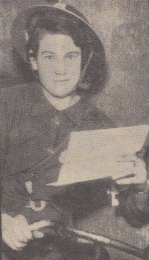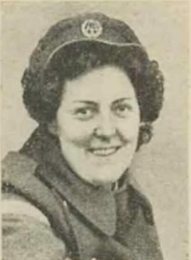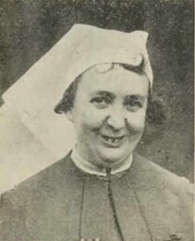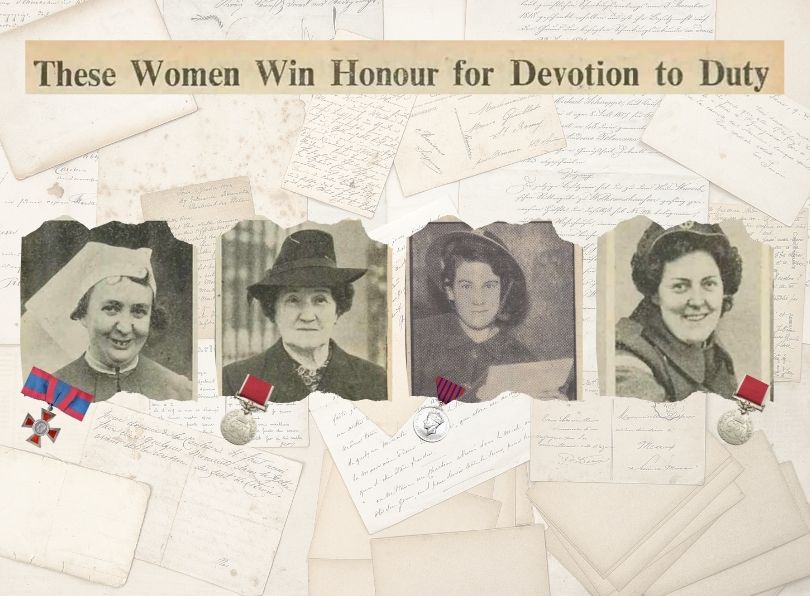Celebrating inspiring women’s stories from our collections: March is Women’s History Month, and 8th March is International Women’s Day.
Inspiring women’s stories can be found throughout our vast world of collections on Forces War Records and Newspapers.com. From nurses to home front workers and Auxiliary Territorial Service members, their incredible acts of bravery, sacrifice and heroism are plain to see. We’ve delved into our collections to bring you 4 inspiring women’s stories from WWII.
Charity Bick, Air Raid Precautions Despatch Rider

‘She displayed outstanding courage and coolness in very trying circumstances.’
Charity Bick was a Despatch Rider in the West Midlands during the Blitz and is the first of our inspiring women’s stories. Despatch riders operating on motorcycles were tasked with delivering messages and ensuring they reached the Report and Control Centres. For her bravery during an air raid in November 1940, summarised below from her citation, Charity was awarded the George Medal.
FWR Tip: Our Medals page allows you to browse all kinds of medals, from campaign and gallantry awards to military and civil decorations. Discover the medal’s origins, how a recipient qualified and a photo of the award.
When incendiary bombs began to fall, Charity assisted her father, a Post Warden, in putting out an incendiary on the roof of a shop with a stirrup pump and bucket of water. The pump proved to be out of order, and undaunted, she splashed the water with her hands and eventually put out the fire. While attempting to get out of the roof, the charred rafters gave way, and she fell through to the room below and sustained minor injuries.
Almost immediately after Charity and her father returned to the A.R.P. Post, high-explosive bombs began to fall, and a terrific explosion nearly shook them off their feet. They discovered that a bomb had destroyed two houses opposite and another one nearby. The Wardens attached to the Post were all on duty, so she borrowed a bicycle and rushed out to take a message to the Control Room amidst shrapnel from guns and falling bombs. Making repeated attempts to get through, Charity had to dismount several times and fall flat on the ground for safety. Covered with dirt and grime, she eventually delivered the message.
Three times Charity journeyed from her Post to the Control Room, a distance of approximately one and a quarter miles, during the height of the raid and made further journeys afterwards. By acting as a means of communication between the Wardens’ Post to which she was attached and the Control Room, Charity carried out valuable work and released other Wardens for duty.
At the time of the incident, Charity was a month away from her 17th birthday. Read the full citation for her George Medal in our WWII, London Gazette, Military Notices, 1939-1945 collection.
Margaret Mary Cangley, Merchant Navy Stewardess

‘…a splendid example of courage when her ship was shelled by a German submarine.’
Margaret served with the Merchant Navy during WWII, working as a stewardess aboard ships such as SS Jamaica Producer, a steam merchant predominantly carrying cargo and mail. Margaret’s is another of our inspiring women’s stories from WWII, but her experiences were not limited to 1939-1945. We found references to Margaret in our Historical Documents Library and other collections and couldn’t resist delving into the newspapers to learn more about her story.
Margaret was born in Tipperary, Ireland, in 1876. By WWII, she had 40 years of experience at sea across three wars: the Second Boer War (1899-1902), WWI and WWII.
Serving at sea with the Merchant Navy was a perilous endeavour during WWII, with German U-boats posing a deadly threat to Allied shipping. In the first week of the war, Margaret’s ship was shelled by a German U-boat for 40 minutes while she continued her work, reports the Evening Express. The crew were required to abandon the ship, and Margaret jumped for one of the lifeboats, injuring her back in the process, but refused to tell anyone about it. The Evening Express writes that the stranded crew and passengers spent two days and two nights in the lifeboat in a north-west gale. During this time, Margaret mothered five young children. Disregarding her own personal comfort and safety, she gave her coat to one of the children and her life jacket to a young mother.
Undeterred, Margaret was soon back at sea. But 16 days after the sinking, her new ship was torpedoed, and machine-gun bullets spattered the cabin walls during an attack. Margaret stoically carried on, even when the enemy plane crashed into the ship’s mast and dived into the sea. The Huddersfield Daily Examiner reported that as a result of the attack, Margaret spent six days at sea in a lifeboat.
Stays on the homefront were not without danger for Margaret, either. But she continued to demonstrate her brave character. Subject to air raids in London, Bristol and Aberdeen, in one incident, Margaret was staying at a house that the enemy demolished. Inevitably, she “remembered her job”, wrote the Evening Express, and proceeded to help at the warden’s canteen.
For her bravery at sea, Margaret was mentioned in the 1943 New Year’s Honours List and was awarded the British Empire Medal (Civil Division) by the King at Buckingham Palace. She left the Palace to “get ready for my next trip.”
Our Historical Documents Library contains a copy of the magazine The War Illustrated from April 1943, in which Margaret is featured. The photo of Margaret is accompanied by the following testimonial:
‘She was twice a torpedo victim. She attended wounded in a lifeboat, helped to look after passengers, giving a splendid example of courage when her ship was shelled by a German submarine.’
FWR Tip: Researching an ancestor who served in the Merchant Navy during WWII? Try searching for them in our Merchant Navy WWII medal collection. The clues held within could help you search other Merchant Navy collections, like the Merchant Shipping Movement Cards at The National Archives.
Private Margaret Mary Johnson, Auxiliary Territorial Service

‘…her hands were badly burned in her heroic efforts.’
Margaret Mary Johnson of the Auxiliary Territorial Service (ATS), the women’s division of the army, was awarded the British Empire Medal (Military Division) during WWII. It is another example of inspiring women’s stories and an act of selfless bravery.
A native of Altrincham, Cheshire, Margaret, the daughter of a farmer, started the war in the Women’s Land Army (WLA). The WLA carried out farming and agricultural work and were pivotal in keeping Britain fed during both world wars. Margaret was employed on a farm in Pamington, Gloucestershire: ‘She was well-known in that district, and her bright, happy and willing disposition won for her the goodwill of all with whom she became associated.’
Margaret transferred from the WLA to the ATS, working as an ambulance driver in the Home Counties. Her exploits were captured by the national press and were reported in the Daily Mirror.
In December 1942, Margaret was driving her ambulance when she saw a bomber about to crash. Determined to help the stricken crew, she pulled into the side of the road and ran towards the plane. With no thought of her own personal safety, Margaret broke through the canvas screen of the aircraft, just inside the fuselage, where a break had already been made into the bodywork. From here, she attempted to rescue the trapped rear-gunner.
By this time, the plane was in flames, and its ammunition was exploding. Margaret, whose hands were badly burned and was feeling the effects of the fumes from the aircraft, had to be dragged away to safety by a fellow soldier; such was her determination.
‘I have a brother who is training to be a pilot’, Margaret declared. ‘It was the thought of him which decided me to try to rescue the pilot.’
Margaret’s B.E.M. citation reads:
‘She made a gallant attempt to save life with complete disregard for her own personal safety and showed considerable initiative by her prompt action.’
FWR Tip: The Ministry of Defence (MOD) holds ATS service records. You can apply via the MOD website using the ‘Army (including Territorial & Army Emergency Reserve)’ option in the online form. A service record often provides more detail about a person’s military service, helping you piece together their movements and gain a great insight into their wartime experience.
Acting Matron Effie Townend, Queen Alexandra’s Imperial Military Nursing Service

There are many inspiring women’s stories from the nursing services during WWII, and Effie Townend’s astonishing actions grabbed our attention while browsing our collections.
Effie, from Selby in Yorkshire, joined Queen Alexandra’s Imperial Military Nursing Service (QAIMNS) in 1924. The regiment consisted of professional army nurses and also had a reserve wing. She served in Malta for five years and in India for three years. For her gallantry during her time in India before the war, Effie was awarded the Indian General Service Ribbon.
The outbreak of WWII called on the skills and experience of professional military nurses like Effie, who would be tested to the extreme. These skills were vital during the fall of Tobruk in 1942, part of the North African campaign. Allied forces had previously withstood an Axis siege of the Libyan port of Tobruk in 1941. However, in June 1942, renewed Axis efforts led to the capture of Tobruk and the surrender of around 34,000 Allied forces.
Effie assisted with evacuating the wounded, making the journey from Tobruk to Alexandria 11 times. She cared for hundreds of Allied casualties on board a hospital ship in the Mediterranean, ‘displaying remarkable devotion to duty.’ Effie told the press that she had ‘one or two narrow escapes when bombs dropped near her ship.’
For her actions, Effie received the Royal Red Cross Second Class from the King at Buckingham Palace on Tuesday, 2 February 1943.
According to our records, Effie was granted a commission as a Sister on 30 May 1941 and later became an Acting Matron.
FWR Tip: Researching a nurse from WWI or WWII? Our blog on researching nurses contains plenty of hints and tips to help you make discoveries.
Perhaps you have an inspiring women’s story from your own family? Why not share it with us on our Facebook page?
Cover image: The Amalgamated Press Ltd, Bigbury Mint, and Newspapers.com
Sources
Ancestry, Ireland, Select Births and Baptisms, 1620-1911, accessed March 2024.
History Extra, Tobruk: 8 facts about the WW2 confrontation in North Africa, accessed March 2024.
uboat.net, Jamaica Producer, accessed March 2024.
WW2 Civil Defence Uniforms, Insignia, Helmets & Equipment, May 1940 “Operational Control at Air Raid Incidents” Training Memorandum 4, accessed March 2024.


